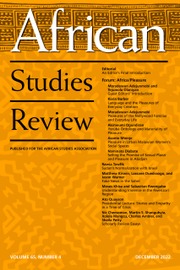This is an impressive and thought-provoking book, a productive departure from the tradition of historical linguistics applied to what is now Uganda. The author almost studiously avoids grandiloquence, focusing on the careful description of changes in the concepts of poverty and wealth across about a dozen languages, Nilotic as well as Bantu, over two millennia. She has distilled a staggering amount of work into these 200 pages.
To order the myriad subtle associations, distinctions, and changes she presents, Stephens uses a fairly straightforward framework. The first chapter provides an introduction to the methods of historical linguistics and of conceptual history based on it, the next a baseline of early developments from the entire region, and the third the environmental-history context, reconstructed mostly from material (archaeological, dendrochronological etc.) sources. Three further chapters trace out changes for three clusters of languages over the last ca. 1500 years, and a final chapter discusses changes associated with the precolonial and colonial periods. In every case, Stephens considers the social, material, and psychological overtones of the reconstructed concepts of poverty and wealth.
Although a non-linguist sometimes risks getting lost in this panorama of roots, derivations, loaning, and associations, some big points emerge very clearly. One is just how wrong modernist assumptions about egalitarianism or uniformity of poverty in “traditional” rural societies were, whether or not the supposed egalitarianism was seen positively. Economic inequality is clearly traceable across the board. That said, there is no clear correlation between the scope for social differentiation that can be estimated from information on environmental conditions and livelihood styles, and the richness of vocabulary associated with poverty and wealth. Some societies developed greater traceable conceptual ranges than others, for no apparent reason.
Another point that applies everywhere is the close association of poverty with other states of suffering—physical wasting, loneliness, bereavement—and that of wealth with high status. Nevertheless, in this regard the book also demonstrates highly suggestive differences. The association of wealth with elderhood, for instance, appears strongest in societies where forms of exchange—mostly of wives and cattle—were economically central that elders could control with relative ease. Elsewhere, wealth was more strongly associated with careful use of limited resources. In reasoning these associations through, Stephens is thankfully unapologetic for making strong associations between environmental change, and in particular environmental stress, and conceptual change. The book is a reminder of the extent to which preindustrial societies were at the mercy of their environments, and that industrial ones may still find that they aren’t much better off.
It is also evident from Stephens’ analysis that poverty and wealth consistently invite judgment, both moral and reputational. In this regard, the study serves as a reminder of the variability of mindsets on inequality across the continent. For this reader, more accustomed to Tanzania, the attention to status and social competitiveness of present-day Uganda is striking. Stephens shows that this diversity is of long standing. That said, it is also with regard to these judgments that both the suggestiveness and the inconclusiveness of Stephens’ evidence become striking.
Take, for example, Stephens’ discussion of the association of “poverty” with “disruptiveness” and “torture” in the proto-Eastern Nilotic language, around 1100 years ago. She takes it fairly straightforwardly as evidence of a negative attitude towards the poor as a source of trouble, either inflicting torture on the more fortunate or provoking its infliction on them for being troublesome. Yet considering that some speaker communities, in Africa and elsewhere, allow circumstance and happenstance a great deal of agency over humans, there is another possibility. What if the association with disruption and torture reflected the power of adverse circumstances, rather than irate neighbors, over the poor? Could it be that the condemnation is directed towards the cruelty of fate or of an unforgiving environment?
Such different readings may be coincidental or purely personal, but they may also derive from different (in this case, Indo-European) speaker communities of origin: arguably, Anglophones judge poverty more harshly than others. To be clear, this observation is not meant to endorse a view of language as “defining thought.” All languages carry within them the means to identify and critique implicit ideologies. Rather, what follows is that it would be marvelous if more historians, with different antecedents, turned their attention to the kind of material that Stephens works with. Even for this study, there are so many adjacent terms, which would shed further light on the histories at play. How about notions of witchcraft, often used to critique wealth? How about those of compassion and charity? It is to be hoped that Stephens pursues her way of working further, and that others take it up.

